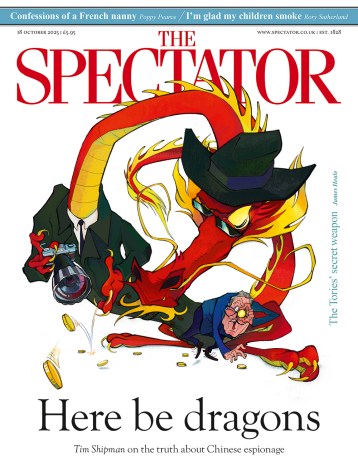One day in 1938 Alberto Giacometti saw a marvellous sight on his bedroom ceiling. It was ‘a thread like a spider’s web, but made of dust’, an object that was both ‘very, very fine’ and in constant motion, like a snake except that ‘no animal’, he thought, had ever made such movements: ‘light and sweeping and always different’. This was, you might say, a revelation of the beauty that lay in extreme thinness and fragility.
In Giacometti: Pure Presence at the National Portrait Gallery you see that process of attenuation occurring, in different ways, again and again in his art. In a bronze bust of his younger brother Diego, from 1955, the sitter’s upper body is substantial enough, but his head, with its angular profile, has become as slender as a blade.
A painting of the writer Jean Genet from about the same time (1954–5) shows the sitter, his head relatively much smaller than his torso, apparently sunk to the bottom of a large, grey tank of space. All the mature work by Giacometti (1901–66), whether from life or not, was about the immense difficulty — as he saw it — of making a sculpture or painting that accurately pinned down what he saw when he looked at a model.
It had not been like that at the start. The son of Giovanni Giacometti, a successful post-impressionist painter, young Alberto worked with precocious ease to begin with. The first exhibit, a bronze head of Diego, dates from 1914, when the artist was barely in his teens. There followed a series of accomplished paintings and sculptures of himself and his family. But a few years later, it abruptly got harder, and stayed that way.
Every day, almost every time he looked, it seemed to change. The most familiar faces, he complained, were the most difficult. The ever-faithful Diego was his first subject, and his last. At least, in this exhibition where the final work is a sculpture, ‘Diego Seated’ (1964–5), in which the figure seems to flicker and dissolve as the artist’s fingers kneaded the clay, again and again.
In between those two sculpted portraits, Diego sat for thousands upon thousands of hours, but the process never became any easier. Sometimes Giacometti felt he had made a little progress, then it turned out he was wrong. Paul Moorhouse, the NPG curator, aptly quotes Samuel Beckett, a friend of the artist, with his injunction to ‘fail again, fail better’. So he spent a lifetime attempting to depict a small number of models — Diego, his wife Annette, his mother, a younger woman named Caroline — despite in his own view never remotely succeeding.
Although the works in the exhibition are ostensibly portraits, they have little sense of individual personality, psychology or even appearance. The people seem more like everyman and everywoman, staring out. The subject is more, as Jean-Paul Sartre put it, ‘pure presence’: another human being looking back at you. That, and the sheer impossibility of adequately fixing that experience in paint or clay. The result is that the exhibition is simultaneously repetitive and compelling. Giacometti was saying more or less the same thing, again and again, but with an intensity that never flags.
No doubt he was in the grip of obsessive compulsions. His refusal to leave his tiny, comfortless studio — which he described as ‘too small, just a hole’ — suggests as much. Giacometti’s existence, eternally attempting the unachievable, while dwelling in a sort of hermit’s cave, is a theme from Beckett — or perhaps a piece of performance art.
Yet, however idiosyncratic he might seem, Giacometti was a hugely influential artist. This was because, more than anyone else in the years after the second world war, he demonstrated that — far from being tired and finished — figurative art remained challenging, indeed dauntingly obdurate, but full of potential.
This was a starting point for many artists of the post-war era. Frank Auerbach, about whom I wrote last week, is one. Another was Peter Lanyon, whose gliding paintings are the subject of an excellent, small and sharply focused exhibition at the Courtauld Gallery: Soaring Flight.
Lanyon (1918–64) is sometimes bundled with contemporaries in the St Ives group such as Patrick Heron, and his work regarded as ‘abstract’. The Courtauld show makes clear that, on the contrary, he was determinedly and explicitly a landscape painter or — as he liked to term his later pictures, which are the theme of the exhibition —an exponent of the ‘airscape’.
Just like Giacometti, Lanyon was after something elusive. A painting such as ‘High Wind’ (1958) represents a real experience —being buffeted by gusts of turbulent air. But it manages to do so without reproducing any identifiable object. Thus it is not exactly representational, but scarcely abstract either. It powerfully transmits the feeling of standing in a swirling gale.
A year after he painted this, Lanyon took — quite literally — to the air himself. He started gliding, and, until he was killed as the result of an accident at only 46, many of his paintings were about the experience of flight.
They are big canvases that envelop you, giving the impression that you are surrounded by clouds and thermals. There is no fixed viewpoint. In ‘Rosewall’ (1960) the sky is all around the edges of the canvas, and the green Cornish land in the middle. Somehow, this gives a more vivid sense of atmospheric turmoil and vertigo — Lanyon suffered from a fear of heights — than any more photographic depiction could. You leave convinced that Lanyon was the master of a distinctive genre: aerial art.






Comments